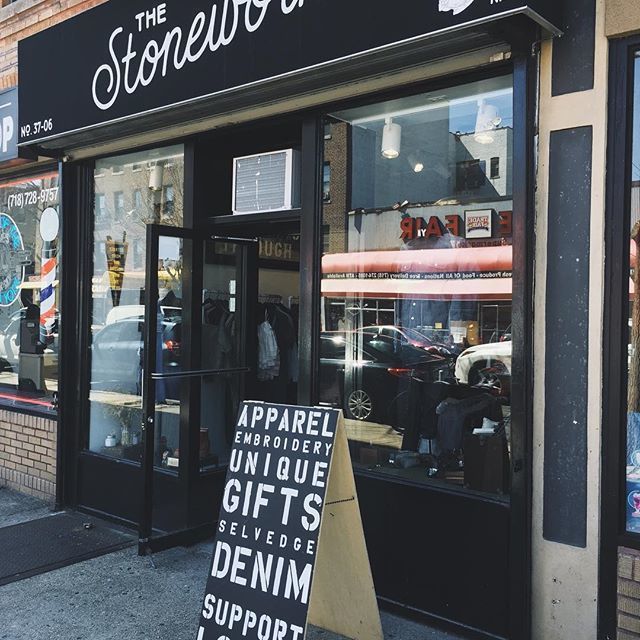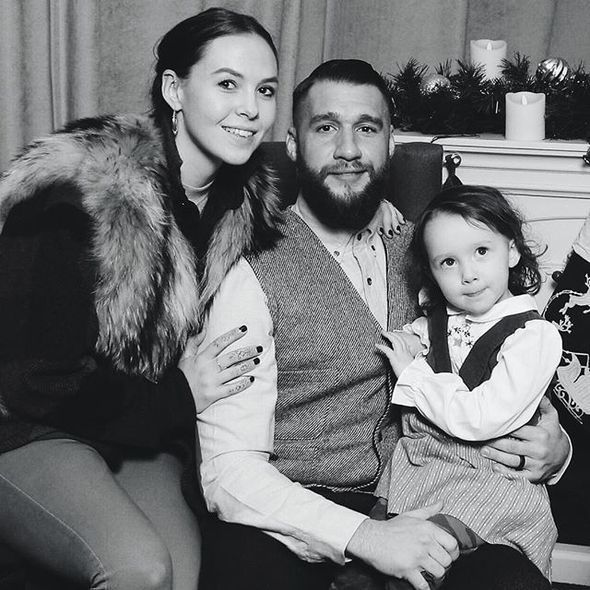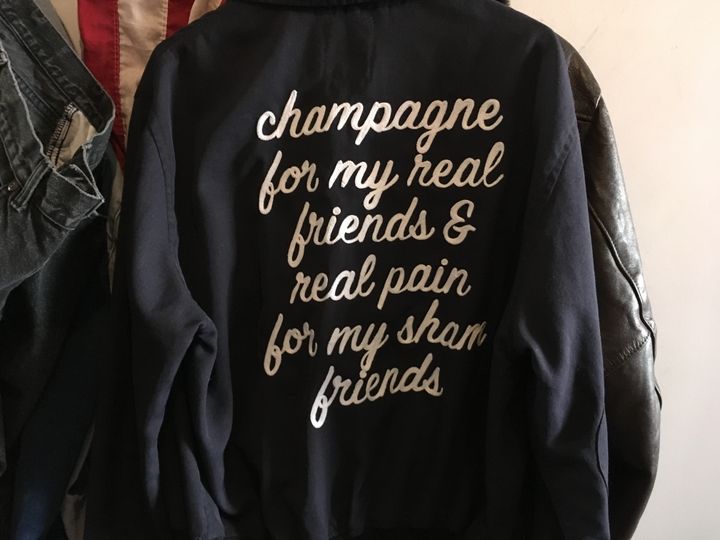
Ana Stone
Ana Stone loves a good message.
And a good story behind everything she makes.
Armed with a breadbox sized Cornely chain stitch machine with a foot powered motor and hand crank operated device that embroiders a linking chain on fabric, Ana can be found sharing her skill with people at events and in The Stonework, her own boutique nestled between a barber shop and a Japanese restaurant on Ditmars Boulevard in Astoria, Queens.
Ana is one of a select group of Community Champions being feted by the Queens Council on the Arts at the upcoming Caribbean Carnival 2018 Gala.

The Stonework, 37-6 Ditmars Blvd, Astoria, NY 11105
Tell me about your business
“The Stonework was originally a classic menswear boutique carrying heritage apparel and goods that celebrate the history of American workwear. We carry brands that have become American institutions in clothing; like Schott Brothers - noted for inventing the motorcycle jacket and for being the first company to put a zipper on a jacket, Red Wing Shoes, who have been making work boots in America since their first pairs of Iron Rangers in 1905, as well as local brands including Left Field NYC located in Ridgewood, Queens, who source some of their raw selvedge denim from the last remaining denim mill in the United States, the Cone Mills White Oak plant in Greensboro, NC.

Ana, James & Story
I opened the store on my own, and didn’t realize how involved my husband would become. Now I consider him my business partner. He is a blue collar guy who believes in the importance of supporting American made products. When he isn’t selling jeans in our shop, he’s working the fights where he’s a cutman for various Muay Thai and boxing events. People are so surprised to find out he also works full time underneath NYC in manholes for Con Edison where he puts the quality of the clothing we sell to the test.
After being unhappy working for someone else and a trip to Moab, Utah, a truly mystical place, we decided to set up shop and opened The Stonework a few months later on October 1, 2016.”

Buy Colchester and get a story with your sneakers!
Talk to me about denim
“We sell raw, selvedge denim in our shop. Raw refers to the finish on the denim, or lack there of. Raw denim is denim it its original state. It has had no washes or treatment and it is up to its wearer to break it in and create a pattern of fades entirely unique to the person wearing them. The selvedge refers to the self finished edge of the fabric, where the denim was locked into the loom.

Selvedged denim
“It’s ironic,” Ana shakes her head with a smile. “Denim experienced a boom post WWII, as the market changed from utility to fashion. The narrow shuttle looms that produced the selvedge denim couldn’t keep up with the new demand and the selvedge was lost in order to produce jeans at a higher volume. Japan ended up buying a lot of the American looms that could produce selvedge denim, and to this day, some of the best denim comes out of Japan on old American machinery. There is one remaining denim mill left in the entire United States, the Cone Mills White Oak plant, in Greensboro, NC and they are unfortunately closing their doors at the end of this year, but we are proud to carry jeans made out Cone Mills denim at The Stonework. We are so fortunate to have the customer who appreciates US made clothing with history and tradition behind it. We love being a local business supporting real people. That is what our customers love about us.”
What is your interest in the arts?
“I come from a family of artists and was always encouraged to be creative. I dropped out of FIT’s fashion design program and got a great job as an editorial stylist, I did some visual merchandising, working with a lot of artists to create product displays and after I had my first daughter, I went back to work at a small boutique in Astoria, Queens as the buyer and manager. After having kids, I decided I needed to be my own boss, and I went out on my own. I had no idea that opening my own store would also lead to me becoming a full time chain stitcher.

An original piece by Ana Stone.
This jacket is an example of something I wanted to do. For every few commissioned pieces I get, I made it a rule to take a break and do something of my own idea and design. Chain stitch embroidery is an old world process, what’s interesting to me, and to many people, is how it has become art. Chain stitch embroidery is how all embroidery was done prior to computers, it was a trade and served a utilitarian function. You saw a lot of business advertising on clothing, sports teams and logos being embroidered. I like to bring my machine out to events because it is so hard for people to wrap their minds around the fact that the embroidery I create is not computer generated or hooked up to a computer somehow. It is a machine with a foot powered motor, gear mechanisms and all the work is guided by a hand crank that controls the direction of the needle. I only know 1 man who can repair my machine and he’s in his seventies. There is a huge generational gap between guys like him and people like me. The machines are all very old, they don’t make them anymore and are very rare, but fortunately, I am seeing a resurgence of chain stitchers in New York and across the country.
Although the store started out carrying only menswear, I started to get a lot of requests from women so now I carry clothing for women as well, including some of those American brands like women’s Schott Perfecto motorcycle jackets and Red Wing Heritage women’s shoes. Custom embroidery is a huge part of my business, especially for women. Around 80% of my custom embroidery customers bring me a favorite garment and want something specific embroidered for them. Since it’s hard for people who don’t embroider to understand what will translate well to chain stitch embroidery, my favorite customers are the ones who say ‘this is what I want it to say, but I trust you to do it how it will look best.’ This past year I have been asked to do many women centric themes, a lot of RESIST, NEVERTHELESS SHE PERSISTED, A WOMAN’S PLACE IS IN THE RESISTANCE on vintage cameo jackets, bags and jeans. I embroidered over 100 ‘#METOO’ patches and gave some to every womens’ boutique in the area for them to give away free, only asking for donations to support the Joyful Heart Foundation. One girl asked me, ‘Can I take some for my friends too? We all need these...’ It was so empowering and bittersweet. Embroidery can make a powerful visible contribution and I was so honored I could give these to other people and continue important conversations and make connections amongst strangers.”
Do you think art can change the world?
“Yes. All art can say something. Being able to write it out and wear it is meaningful to me. Having a powerful message on the streets is inspiring to me and I’m so glad to be a part of it. People will tell me, ‘I saw a girl wearing one of your jackets and want one.’ I love seeing people wear one of my pieces. It’s like having a little embroidered army walking on Ditmars Boulevard.”
What are your thoughts about the arts in Queens at this moment in time?
“I think huge strides are being made in Queens. In the past year, I have seen a large number of new makers popping up. There is a great new market called the Queens Craft Brigade that features all Queens based makers and artists. A lot of the independently owned retail shops here in Astoria all ban together and organize retail crawls and events for the community, and tons of us support local makers and artisans by selling their products or hosting pop up shops for them to display their goods.”
In your opinion, what is the distinction between being an artist and being a maker?
“My husband just told me the other day how he wants to have a skill like I have, to be able to make something to give to someone. James is a hat guy, so we signed up to take a millinery class at FIT, and soon he’ll be adding bespoke hats to The Stonework arsenal. I think that’s the distinction, that makers create things with a purpose, things that are meant to be used as well as being aesthetically pleasing. That’s why I love embroidery so much, I can be both an artist and a maker, and have something to say.”
Want to see more?
Check out The Stonework on Instagram
About the Author: Hoong Yee Lee Krakauer helps artists & creative people grow their careers with great grant writing strategies & mindsets she has developed over 15 years as an veteran grant panelist, grant maker & grant writer. Get her FREE Master Grant Strategy Worksheet and insights from a grant reviewer’s point of view.
